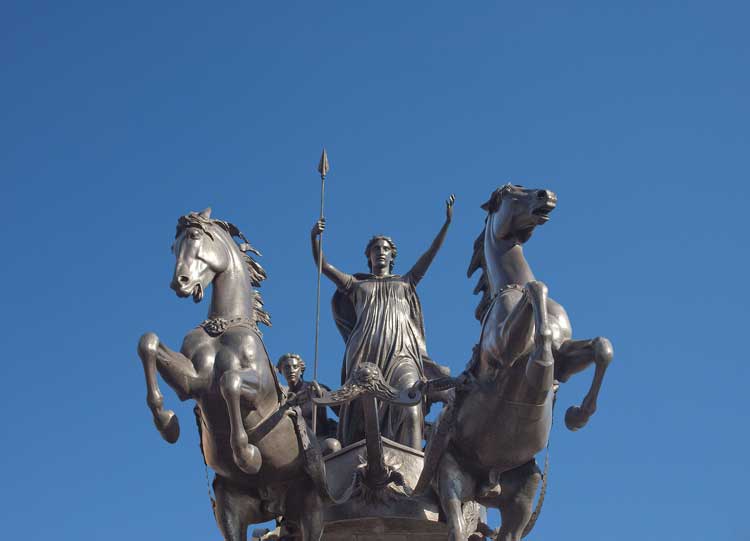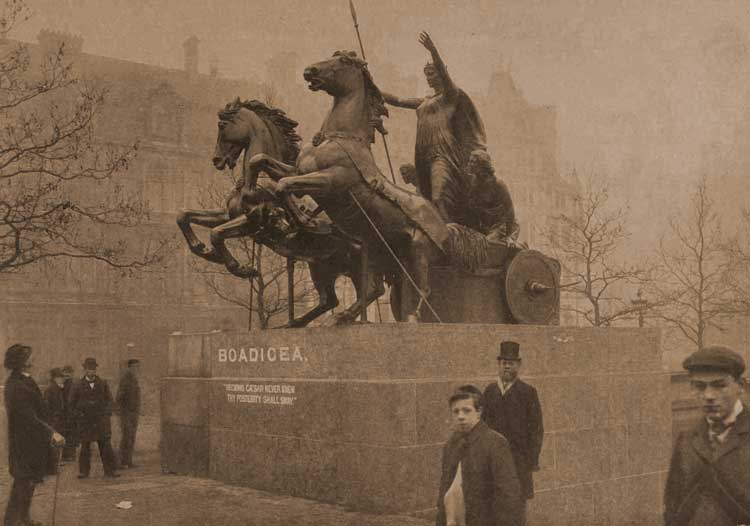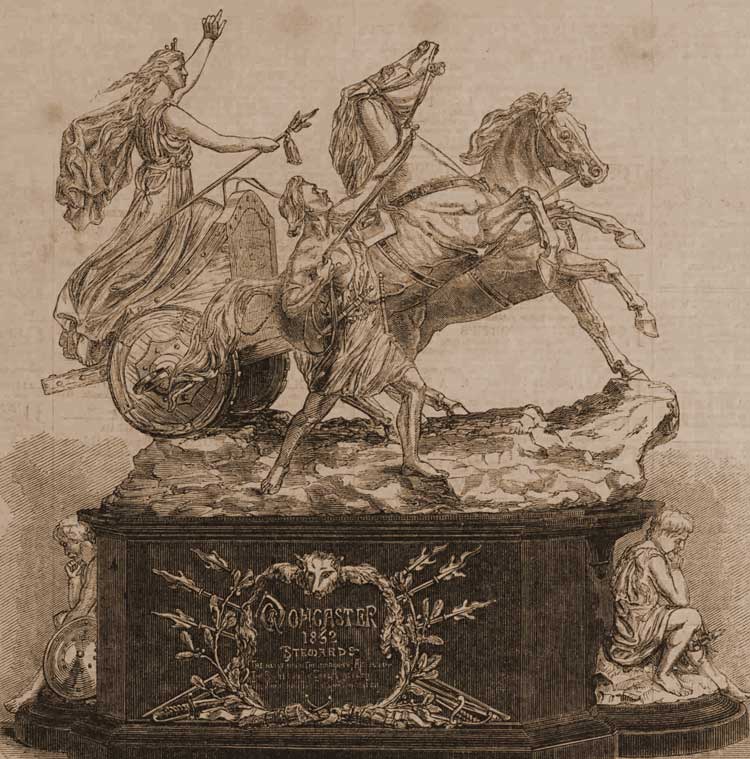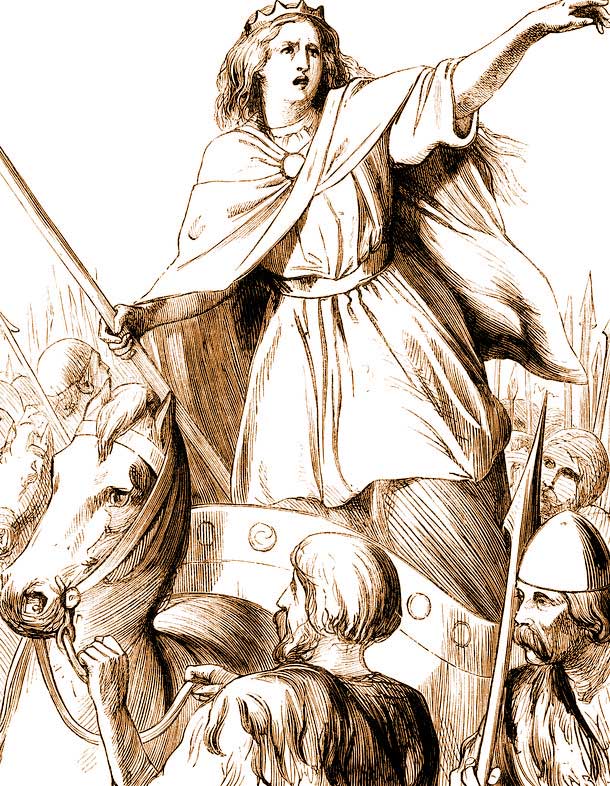
Boudicca, Boudica or Boadicea (AD30 -AD61), was the Queen of the British, Celtic Iceni tribe, whose territory stretched across much of what is now East Anglia.
However, her major achievement, that of almost stopping the Roman colonisation of Britain in its tracks, would take her beyond the boundaries of her lands, and ensure that her memory lived on, long after her death.
She is one of the most iconic women in history, as well as also being one of the most enigmatic figures from the Roman occupation of these lands.
A splendid statue of her in her throne-like chariot, ferocious spikes protruding from its wheels and pulled by two rearing horses, has adorned the north side of the western end of Westminster Bridge since 1902. She stands, proud, upright and defiant, a spear in her right hand, her left hand held aloft, urging her followers on.
She oozes confidence, and her message is quite clear, "Don't mess with the Queen of the Iceni, Buster!"
However, you can's help but wonder at the logic behind erecting a statue of her in such a prominent position in the Capital.
After all, her greatest contribution to the history of London, was to burn it to the ground in the year AD61.

If you were to dig deep into the ground beneath London, Colchester or St Alban's, you would eventually come to a stratum of reddish-brown ash, peppered with scorched pieces of Roman pottery, which archaeologists call "Boudicca's Layer."
It is the only physical evidence of a rebellion that, very nearly, changed the course of British history.
The woman behind the firestorm is an historical enigma about whom very little is actually known.
Even the spelling and pronunciation of her name are subject to considerable debate.
Boudica is probably the most accurate; Boudicca is the most common today; Boadicea is certainly the best known.
But, intonation aside, in the Celtic language of the Iceni tribe, whose leader she was, her name simply meant "Victory".
When the Emperor Claudius (10BC - 54AD) ordered the invasion of Britain in AD 43, Boudicca's husband Prasutagus was one of the many tribal leaders who agreed to become a client-king of Rome. This pragmatic submission left him as ruler of his people whilst, at the same time, affording him the comforts that came with being a part of the Empire.
When he died in AD60, Prasutagus left half his estate to the Roman Emperor (now the infamous Nero) and the other half to his wife and their two teenage daughters.
But, Rome's local administrator, Decianus Catus, declared Boudicca's tribal lands a slave province and sent troops to her palace, where they seized Boudicca, raped her daughters, and submitted the Queen of the Iceni to the humiliation of a public flogging.
Their actions turned a willing collaborator into an implacable enemy and lit a flame of resentment that would cost the lives of more than 100,000 people and almost lose the Roman's their foothold in Britain.
Boudicca's revenge was well planned and ruthlessly executed.
First, she forged an immense alliance of disaffected tribes; and then she waited until the cream of the Roman army, under their commander Seutonius Paulinus, was far way on the Welsh coast, suppressing the last druid stronghold on the Island of Anglesey.
Then, with cold-blooded efficiency, she hit back.
With a vast army of some 120,000 tribesmen, she rampaged across eastern England, torching Roman settlements and heading towards the ultimate symbol of Roman occupation, Camulodunum on the site of modern Colchester.

The ill-prepared residents, consisting largely of retired soldiers and their families, managed to hold out for two days.
They sent messengers to Londinium (London) imploring Procurator Decianus to send reinforcements to help fight off the rampaging horde of native fury. Decianus's response was to dispatch a paltry two hundred soldiers, who were quickly overcome by the native militia.
Camulodunum's surviving citizens retreated to their Temple where, for two more days, they cowered behind its thick walls, listening to the sounds of the carnage outside as Boudicca and her followers sacked the town and, finally, torched their sanctuary.
We can only guess at the agonies endured by the thousands of unfortunate colonists as the acrid smoke came creeping towards them and the searing heat of Boudicca's revenge incinerated them.
The Roman Ninth Legion, based in Lincoln, had already been despatched to relieve Camulodunum, but the Britons ambushed them en route and annihilated the infantryman, leaving the demoralised cavalry to retreat back to their base.
When news of this humiliating defeat reached Procurator Decianus, he gathered his entire staff and fled to Gaul.
With Boudicca's forces snowballing towards Londinium, Suetonius Paulinus ordered his troops to return, and he then rode on ahead, hoping to save the city.
But, on arrival, he realised that it would be impossible to defend and, taking with him those who wished to leave, he headed north to rendezvous with his army, leaving Londinium at the mercy of of Boudicca's furious forces that came sweeping into the city, fired the buildings and slaughtered the remaining inhabitants.
The settlement of Verulamium – today's St Albans – was next to feel the wrath of Boudicca's revenge as her, seemingly unstoppable, army sacked and burnt it en route to their inevitable confrontation with the army of Seutonius Paulinus.
Yet, we know virtually nothing about the ensuing battle, nor do we have any definite idea as to site or even the locality of the encounter.
Common consensus is simply that it was somewhere in the West Midlands.
The Roman historian, Tacitus (AD58 - AD120), records only that Suetonius sought a site that would assist his heavily outnumbered soldiers and settled on "a spot encircled with woods, narrow at the entrance, and sheltered in the rear by a thick forest."
An open plain lay before him, thus ensuring that the enemy could only attack from one direction.
As the rebel force amassed for the final battle, so too did their families, taking up position behind the warriors to cheer and applaud the victory that they were sure was theirs.
Boudicca, with her two daughters before her, drove through their ranks in her chariot.
"Look round and view your numbers," she is said to have told them. "Behold the display of warlike spirits and consider the motives for which we draw the avenging sword. On this spot we must either conquer, or die with glory."

Seutonius, meanwhile, was imploring his soldiers to "Keep your ranks; discharge your javelins; rush forward to a close attack and hew a passage with your swords. Pursue the vanquished, and never think of spoil or plunder. Conquer, and victory gives you everything."
As the screeching throng of Britons came rushing towards them, the Romans held their ground in a tight phalanx. Seutonius waited until his opponents were within range and then gave the order to attack.
A volley of javelins hailed down upon the Britons, followed by a wave of infantry and cavalry that charged into their ranks and cut them down en masse.
The surviving rebels turned to run, but found their way blocked by their own families.
The Roman's closed in, and the gory fracas that followed saw men, women and children hacked to pieces.
Boudicca, rather than face the inevitable humiliation of capture, is said to have poisoned herself and was buried by her people at a secret location, that some claim now lies deep beneath Platform ten of Kings Cross Railway Station!